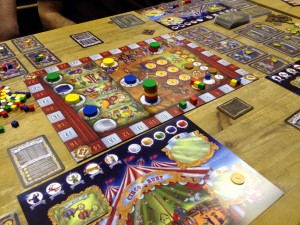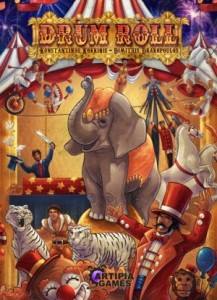Review: Drum Roll
Posted by James (admin) on November 21st, 2011
 In Drum Roll, players are putting on circus shows with the winner scoring the most prestige points (PPs) after three performances.
In Drum Roll, players are putting on circus shows with the winner scoring the most prestige points (PPs) after three performances.
To score PPs, players need to hire performers (which costs cash) and give them the enough equipment, costume, etc. (represented by colour cubes) so that they can give great performances. Each performer can give a 1-, 2- or 3-star performance; however, each performer needs a specific colour cube for each level of performance – so a 3-star performance requires 3 cubes of the exact colours. Each of the 5 types of performer give different benefits (gaining cubes, generating cash, reducing salaries, etc.) and the better the performance, the better the ability. Instead of delivering their 3-star performance benefit though, the player can flip that performer’s card which earns PPs (and reduces their salary each round) but means they player can not use their ability any longer.
Each round, players first take turns placing their 3 action markers to select which actions they will get to execute and then the actions get executed. Five of the actions are to gain 1 specific coloured cube, but only 1 player can use each of these and players can’t use more than one of these actions each turn. Some other actions can be used by multiple players; however, some get executed in order of when they were claimed – this is important because there are only 5 performers and 4 personnel to pick from each round, so other players who picked the relevant hiring action before you may take the ones you wanted.
As a result, placing action makers is often a tricky (and enjoyable) decision as you work out what you need to do, what’s most important to you, and what you think is most important to other players too.
As well as gaining performers and personnel (which give benefits like exchanging cubes, generating cash, etc.) and cubes, there are two other actions: ticket sales and investments. The ticket sales action generates you instant cash and you’re going to need it as performers need paying after performances or you lose PPs. The more you use ticket sales action each round, the more cash you get each action. The investment cards cost 1 cash each but give you extra one-off abilities like gaining cubes, extra PPs for great 3-star performances, etc.
Each turn, new performers and personnel fill in the gaps of those already hired (and any remaining get slightly cheaper). After 5-7 turns, the round ends and each player’s show takes place. Players use the abilities of their performers (any performers without any cubes at all walk out although only after being paid off too).
Other ways to earn PPs come from end of game bonuses such as having more than 8+ performers, having one of each type of performer, etc. Also, each player has a location tile each each round which will award extra PPs if the player has the types of performers stated on the location – players pass these clockwise during the game so you can see what performers will be liked by your next audiences beforehand.
 Overall, Drum Roll is primarily a worker placement game combined with an efficiency engine too. Cash is very tight and gaining cubes (especially of the right colour) is always tense and slower than you’d like. You can’t re-assign a cube once it is assigned to a performer (even if they get fired or walk out) but then you can’t delay assigning them for too long because you can only assign 2 cubes to your performers each turn (so you can’t collect a load and then assign them in one go once you know the optimal allocation). This all combines to make a tight game of hard graft where every decision feels like it counts. As a result, I found it very enjoyable (although I think it could be quite unforgiving if you make one bad choice or what you really need is not available).
Overall, Drum Roll is primarily a worker placement game combined with an efficiency engine too. Cash is very tight and gaining cubes (especially of the right colour) is always tense and slower than you’d like. You can’t re-assign a cube once it is assigned to a performer (even if they get fired or walk out) but then you can’t delay assigning them for too long because you can only assign 2 cubes to your performers each turn (so you can’t collect a load and then assign them in one go once you know the optimal allocation). This all combines to make a tight game of hard graft where every decision feels like it counts. As a result, I found it very enjoyable (although I think it could be quite unforgiving if you make one bad choice or what you really need is not available).
Claiming actions offers some good tension as you usually want to be first on several actions at once and often you must bear the stress as another player thinks about hiring the performer you want. Claiming actions is the main player interaction as the performances are all separate but this felt like enough interaction especially as resources and decisions feel to tight to allow any further direct interaction.
The benefits from performer abilities feel quite small in isolation so it’s a game of combining lots of small gains to make progress, as well as finding abilities that compliment each other to generate synergy. For example, a performer may generate you a green cube, but you could then use an agent to convert it to a red cube which you can then turn into a green and blue cube using an agent. However, each of these personnel costs you salary each round so you need to choose wisely.
Whilst the game is relatively simple there are quite a few things to think about and balance as you need to balance cubes with cash, where to place cubes, when to flip performers, etc. Plus, you need to work out how (and when) to convert your cube and money machine into PPs (and that’s tricky too). You often need to alter your plans based on what’s available as the type of performers you want may not be available, or the performer or cube may have been taken by another player this turn.
I wasn’t sure about the circus theme to start with but it works really well and the artwork looks great so I actually liked the theme. The icons used to communicate abilities seem complex to start but, once you understand the game, they do a good job of communicating a lot of different things.
Players new to boardgames may struggle with the interwoven details, especially as I think it could be an unforgiving game, so don’t be fooled by the circus theme that this is light or young. I really enjoyed playing Drum Roll. You’re always thinking making lots of tricky decisions with limited resources and constantly feeling like you’re going to run out of time or money (or both) before you can accomplish your plan.
James.
[Played with 4 players]

